Evaluating Different Methods for Estimating Diameter at Breast Height from Terrestrial Laser Scanning
Abstract
:1. Introduction
2. Materials and Methods
2.1. Study Area
2.2. Data
2.2.1. Field Data
2.2.2. Terrestrial Laser Scanning Data
2.3. TLS Data Preprocessing
2.3.1. Co-Registration, TLS Data Thinning, and Elevation Normalization
2.3.2. Extracting Point Cloud of Individual Stems
2.3.3. Selecting Points for DBH Estimation and Calculating the Projection Binary Images
2.4. Algorithms Used in DBH Estimation
2.5. Estimation of DBH
2.6. Accuracy Evaluation
3. Results and Discussion
3.1. Dataset of Multi-Scan Mode
3.2. Dataset of Single-Scan Mode
4. Conclusions
- The linear least square circle fitting algorithm was more appropriate for the natural secondary forest than the other algorithms. The nonlinear least square circle fitting algorithm was preferable for the plantation. The performance of the Hough-Transform was poor.
- A moderate gray scale threshold of three was the most optimal parameterization for the natural secondary forest. A small gray scale threshold of one was the most optimal parameterization for the plantation.
- In the natural secondary forest, a moderately large height bin of 0.24 m was appropriate for the multi-scan scanning method, and a large height bin of 1.34 m was appropriate for the single-scan scanning method. A small height bin of 0.1 m was appropriate for the single-scan scanning method in the plantation.
Acknowledgments
Author Contributions
Conflicts of Interest
References
- Liang, X.; Kankare, V.; Hyyppä, J.; Wang, Y.; Kukko, A.; Haggrén, H.; Yu, X.; Kaartinen, H.; Jaakkola, A.; Guan, F.; et al. Terrestrial laser scanning in forest inventories. ISPRS J. Photogramm. Remote Sens. 2016, 115, 63–77. [Google Scholar] [CrossRef]
- Aschoff, T.; Thies, M.; Spiecker, H. Describing forest stands using terrestrial laser-scanning. Int. Arch. Photogramm. Remote Sens. Spat. Inf. Sci. 2004, 35, 237–241. [Google Scholar]
- Hopkinson, C.; Chasmer, L.; Youngpow, C.; Treitz, P. Assessing forest metrics with a ground-based scanning lidar. Can. J. For. Res. 2004, 34, 573–583. [Google Scholar] [CrossRef]
- Watt, P.J. Measuring forest structure with terrestrial laser scanning. Int. J. Remote Sens. 2005, 26, 1437–1446. [Google Scholar] [CrossRef]
- Henning, J.G.; Radtke, P.J. Detailed stem measurements of standing trees from ground-based scanning lidar. For. Sci. 2006, 52, 67–80. [Google Scholar]
- Maas, H.G.; Bienert, A.; Scheller, S.; Keane, E. Automatic forest inventory parameter determination from terrestrial laser scanner data. Int. J. Remote Sens. 2008, 29, 1579–1593. [Google Scholar] [CrossRef]
- Huang, H.; Li, Z.; Gong, P.; Cheng, X.; Clinton, N.; Cao, C.; Ni, W.; Wang, L. Automated methods for measuring dbh and tree heights with a commercial scanning lidar. Photogramm. Eng. Remote Sens. 2011, 77, 219–227. [Google Scholar] [CrossRef]
- Vonderach, C.; Vögtle, T.; Adler, P.; Norra, S. Terrestrial laser scanning for estimating urban tree volume and carbon content. Int. J. Remote Sens. 2012, 33, 6652–6667. [Google Scholar] [CrossRef]
- Pueschel, P. The influence of scanner parameters on the extraction of tree metrics from faro photon 120 terrestrial laser scans. ISPRS J. Photogramm. Remote Sens. 2013, 78, 58–68. [Google Scholar] [CrossRef]
- Liang, X.; Kankare, V.; Yu, X.; Hyyppa, J.; Holopainen, M. Automated stem curve measurement using terrestrial laser scanning. IEEE Trans. Geosci. Remote Sens. 2014, 52, 1739–1748. [Google Scholar] [CrossRef]
- Bauwens, S.; Bartholomeus, H.; Calders, K.; Lejeune, P. Forest inventory with terrestrial lidar: A comparison of static and hand-held mobile laser scanning. Forests 2016, 7, 127. [Google Scholar] [CrossRef]
- You, L.; Tang, S.; Song, X.; Lei, Y.; Zang, H.; Lou, M.; Zhuang, C. Precise measurement of stem diameter by simulating the path of diameter tape from terrestrial laser scanning data. Remote Sens. 2016, 8, 717. [Google Scholar] [CrossRef]
- Saarinen, N.; Kankare, V.; Vastaranta, M.; Luoma, V.; Pyörälä, J.; Tanhuanpää, T.; Liang, X.; Kaartinen, H.; Kukko, A.; Jaakkola, A.; et al. Feasibility of terrestrial laser scanning for collecting stem volume information from single trees. ISPRS J. Photogramm. Remote Sens. 2017, 123, 140–158. [Google Scholar] [CrossRef]
- Wang, D.; Kankare, V.; Puttonen, E.; Hollaus, M.; Pfeifer, N. Reconstructing stem cross section shapes from terrestrial laser scanning. IEEE Geosci. Remote Sens. Lett. 2017, 14, 272–276. [Google Scholar] [CrossRef]
- Tansey, K.; Selmes, N.; Anstee, A.; Tate, N.J.; Denniss, A.; Mcroberts, R.E.; Donoghue, D.N.M.; Deshayes, M. Estimating tree and stand variables in a corsican pine woodland from terrestrial laser scanner data. Int. J. Remote Sens. 2009, 30, 5195–5209. [Google Scholar] [CrossRef]
- Trochta, J.; Krucek, M.; Vrska, T.; Kral, K. 3d forest: An application for descriptions of three-dimensional forest structures using terrestrial lidar. PLoS ONE 2017, 12, e0176871. [Google Scholar] [CrossRef] [PubMed]
- Heinzel, J.; Huber, M.O. Tree stem diameter estimation from volumetric tls image data. Remote Sens. 2017, 9, 614. [Google Scholar] [CrossRef]
- Simonse, M.; Aschoff, T.; Spiecker, H.; Thies, M.; Simonse, M.; Aschoff, T.; Spiecker, H.; Thies, M. Automatic determination of forest inventory parameters using terrestrial laser scanning. Proc. Scandlaser Sci. Workshop Airborne Laser Scanning For. 2003, 2003, 252–258. [Google Scholar]
- Pueschel, P.; Newnham, G.; Rock, G.; Udelhoven, T.; Werner, W.; Hill, J. The influence of scan mode and circle fitting on tree stem detection, stem diameter and volume extraction from terrestrial laser scans. ISPRS J. Photogramm. Remote Sens. 2013, 77, 44–56. [Google Scholar] [CrossRef]
- Calders, K.; Newnham, G.; Burt, A.; Murphy, S.; Raumonen, P.; Herold, M.; Culvenor, D.; Avitabile, V.; Disney, M.; Armston, J.; et al. Nondestructive estimates of above-ground biomass using terrestrial laser scanning. Methods Ecol. Evol. 2015, 6, 198–208. [Google Scholar] [CrossRef]
- Xi, Z.; Hopkinson, C.; Chasmer, L. Automating plot-level stem analysis from terrestrial laser scanning. Forests 2016, 7, 252. [Google Scholar] [CrossRef]
- Kankare, V.; Liang, X.; Vastaranta, M.; Yu, X.; Holopainen, M.; Hyyppä, J. Diameter distribution estimation with laser scanning based multisource single tree inventory. ISPRS J. Photogramm. Remote Sens. 2015, 108, 161–171. [Google Scholar] [CrossRef]
- Raumonen, P.; Kaasalainen, M.; Åkerblom, M.; Kaasalainen, S.; Kaartinen, H.; Vastaranta, M.; Holopainen, M.; Disney, M.; Lewis, P. Fast automatic precision tree models from terrestrial laser scanner data. Remote Sens. 2013, 5, 491–520. [Google Scholar] [CrossRef]
- Olofsson, K.; Holmgren, J. Single tree stem profile detection using terrestrial laser scanner data, flatness saliency features and curvature properties. Forests 2016, 7, 207. [Google Scholar] [CrossRef]
- Wang, D.; Hollaus, M.; Puttonen, E.; Pfeifer, N. Automatic and self-adaptive stem reconstruction in landslide-affected forests. Remote Sens. 2016, 8, 974. [Google Scholar] [CrossRef]
- Olofsson, K.; Holmgren, J.; Olsson, H. Tree stem and height measurements using terrestrial laser scanning and the ransac algorithm. Remote Sens. 2014, 6, 4323–4344. [Google Scholar] [CrossRef]
- Sun, H.; Wang, G.; Lin, H.; Li, J.; Zhang, H.; Ju, H. Retrieval and accuracy assessment of tree and stand parameters for chinese fir plantation using terrestrial laser scanning. IEEE Geosci. Remote Sens. Lett. 2015, 12, 1993–1997. [Google Scholar] [CrossRef]
- Srinivasan, S.; Popescu, S.; Eriksson, M.; Sheridan, R.; Ku, N.-W. Terrestrial laser scanning as an effective tool to retrieve tree level height, crown width, and stem diameter. Remote Sens. 2015, 7, 1877–1896. [Google Scholar] [CrossRef]
- Wang, D.; Hollaus, M.; Puttonen, E.; Pfeifer, N. Fast and robust stem reconstruction in complex environments using terrestrial laser scanning. ISPRS—Int. Arch. Photogramm. Remote Sens. Spat. Inf. Sci. 2016, XLI-B3, 411–417. [Google Scholar] [CrossRef]
- Wang, D.; Hollaus, M.; Schmaltz, E.; Wieser, M.; Reifeltshammer, D.; Pfeifer, N. Tree stem shapes derived from tls data as an indicator for shallow landslides. Procedia Earth Planet. Sci. 2016, 16, 185–194. [Google Scholar] [CrossRef]
- Project Benchmarking on Terrestrial Laser Scanning for Forestry Applications. Available online: http://www.eurosdr.net/research/project/project-benchmarking-terrestrial-laser-scanning-forestry-applications (accessed on 4 March 2018).
- Terrestrial Laser Scanning in Forest Inventories: Toward International Benchmarks. Available online: https://www.gim-international.com/content/article/terrestrial-laser-scanning-in-forest-inventories (accessed on 4 March 2018).
- Kankare, V.; Puttonen, E.; Holopainen, M.; Hyyppä, J. The effect of tls point cloud sampling on tree detection and diameter measurement accuracy. Remote Sens. Lett. 2016, 7, 495–502. [Google Scholar] [CrossRef]
- Axelsson, P. Dem generation from laser scanner data using adaptive tin models. Int. Arch. Photogramm. Remote Sens. 2000, 33, 111–118. [Google Scholar]
- Mirzaei, M.; Rafsanjani, H.K. An automatic algorithm for determination of the nanoparticles from tem images using circular hough transform. Micron 2017, 96, 86–95. [Google Scholar] [CrossRef] [PubMed]
- Thomas, S.M.; Chan, Y.-T. A simple approach for the estimation of circular arc center and its radius. Comput. Vis. Graph. Image Process. 1989, 45, 362–370. [Google Scholar] [CrossRef]
- Fast Circle Fitting Using Landau Method, Matlab Central. Available online: http://www.mathworks.com/matlabcentral/fileexchange/44219-fast-circle-fitting-using-landau-method (accessed on 15 March 2017).
- Fitcircle, M. Matlab Central. Available online: http://cn.mathworks.com/matlabcentral/fileexchange/15060-fitcircle-m (accessed on 15 March 2017).
- Al-Sharadqah, A.; Chernov, N. Error analysis for circle fitting algorithms. Electron. J. Stat. 2009, 3, 886–911. [Google Scholar] [CrossRef]
- Liang, X.; Litkey, P.; Hyyppa, J.; Kaartinen, H.; Vastaranta, M.; Holopainen, M. Automatic stem mapping using single-scan terrestrial laser scanning. IEEE Trans. Geosci. Remote Sens. 2012, 50, 661–670. [Google Scholar] [CrossRef]

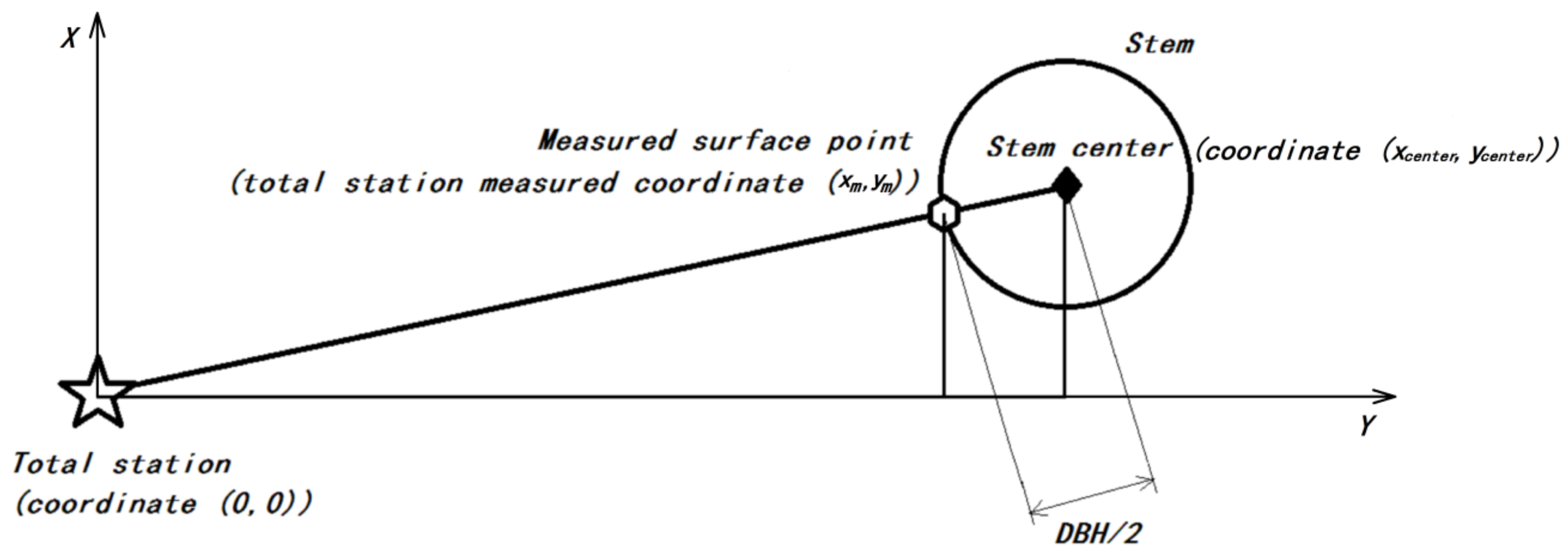
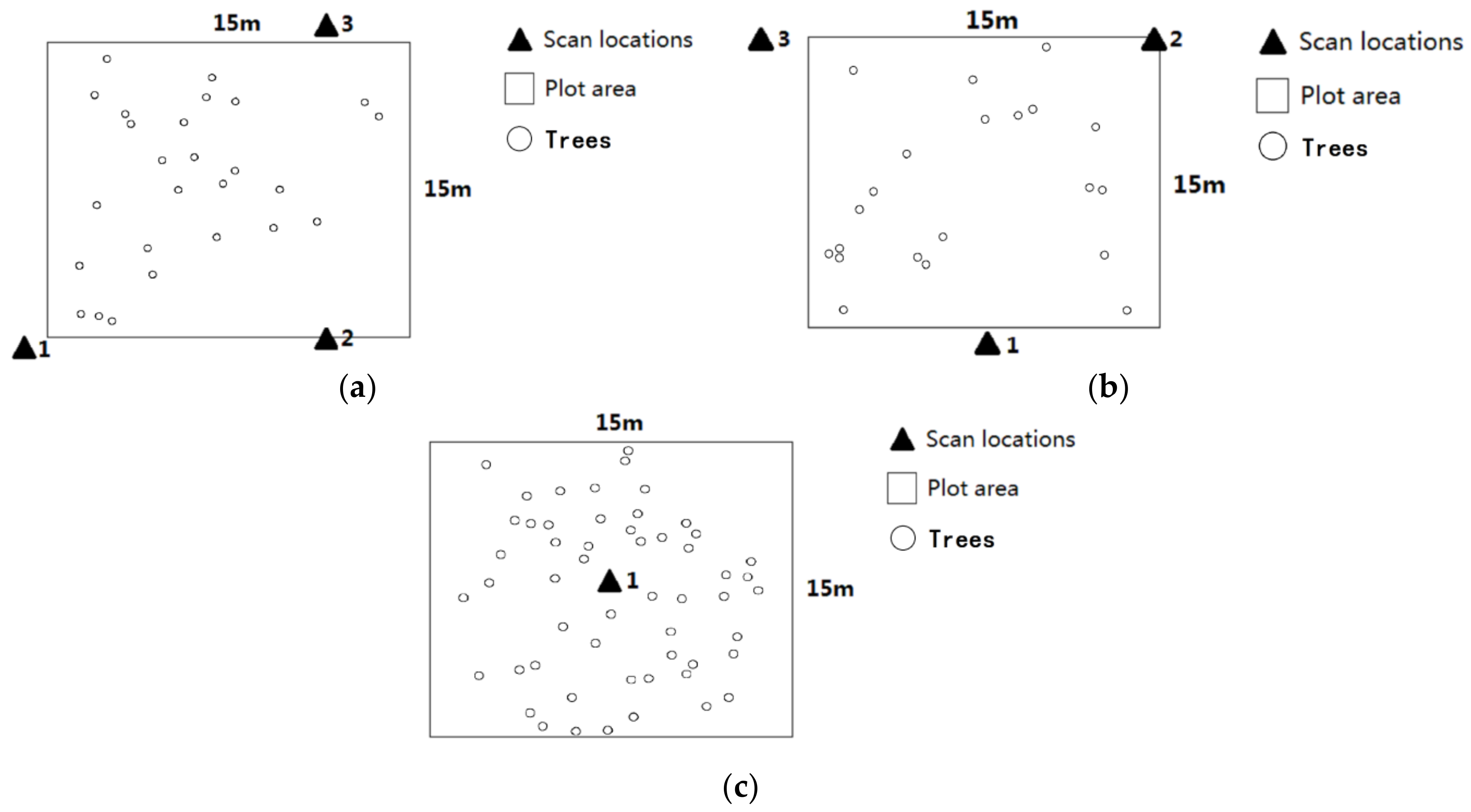





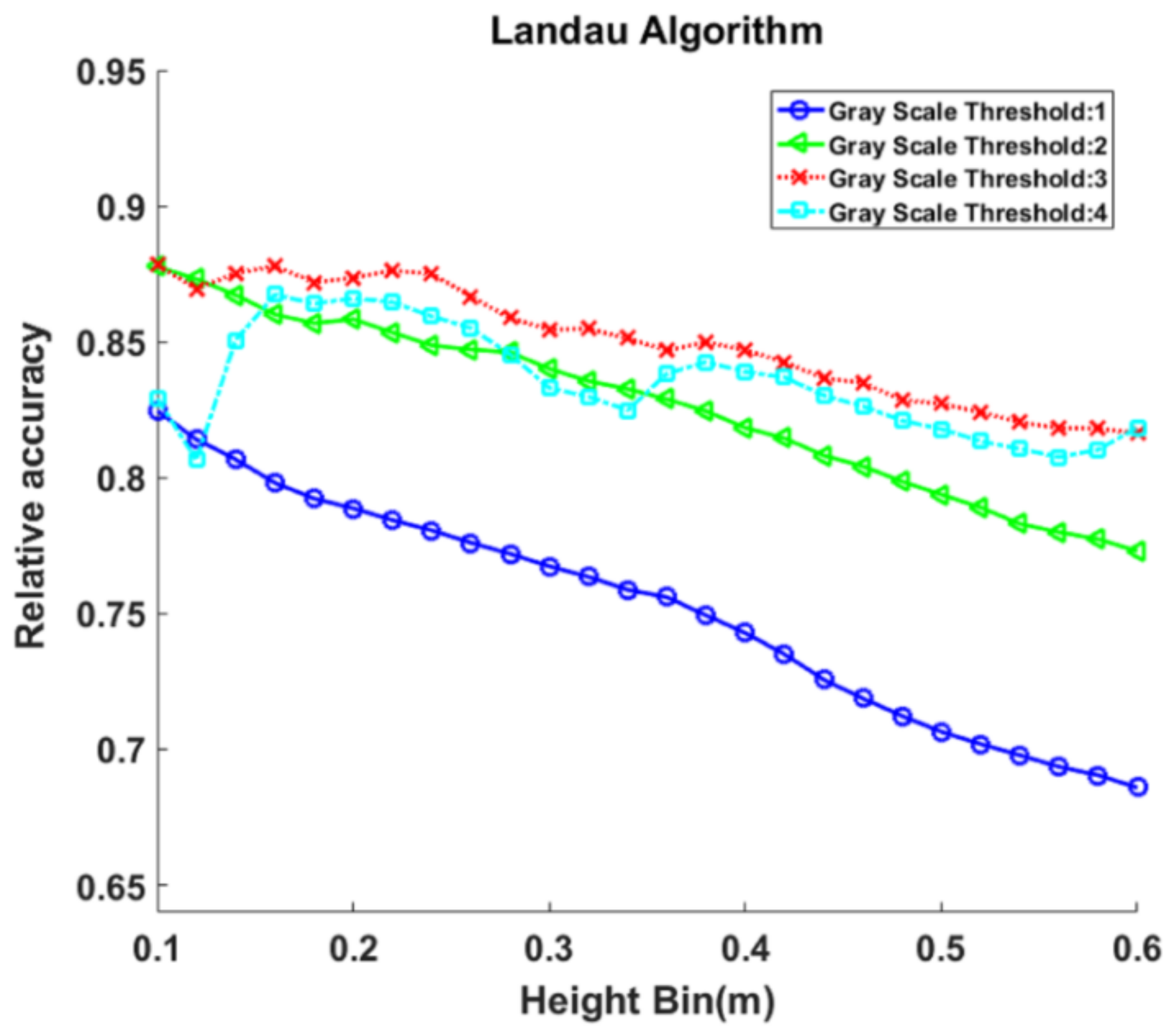
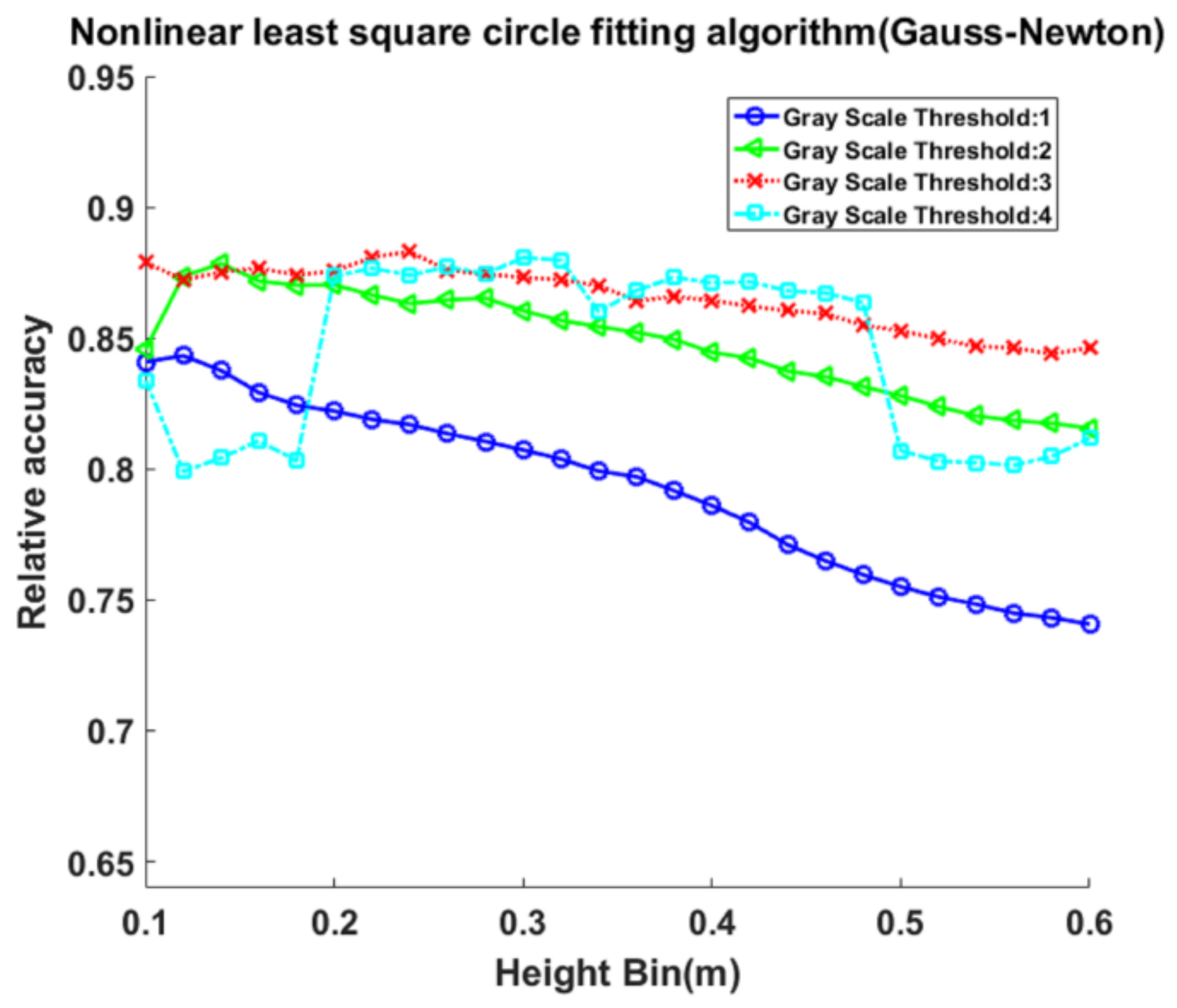
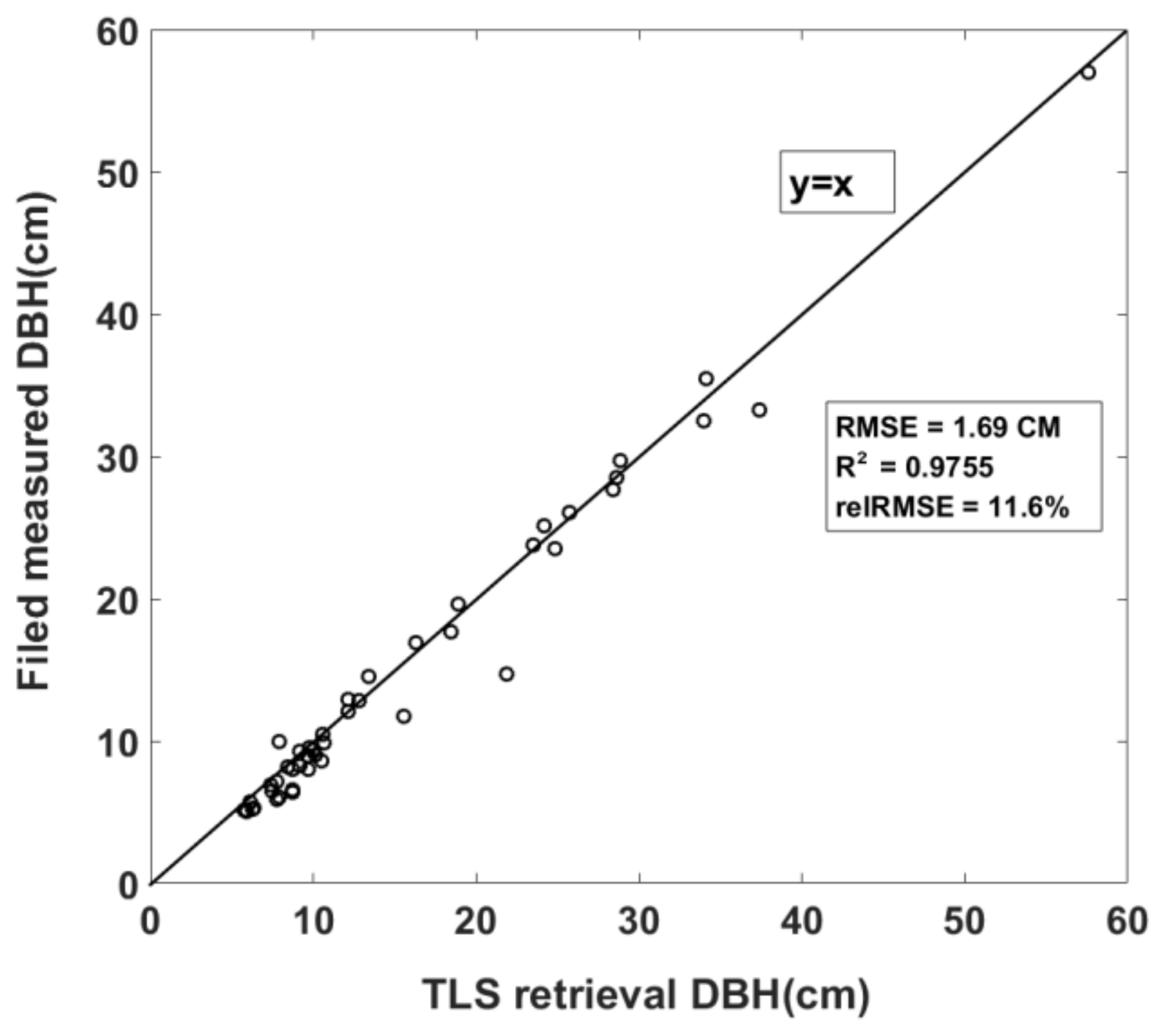

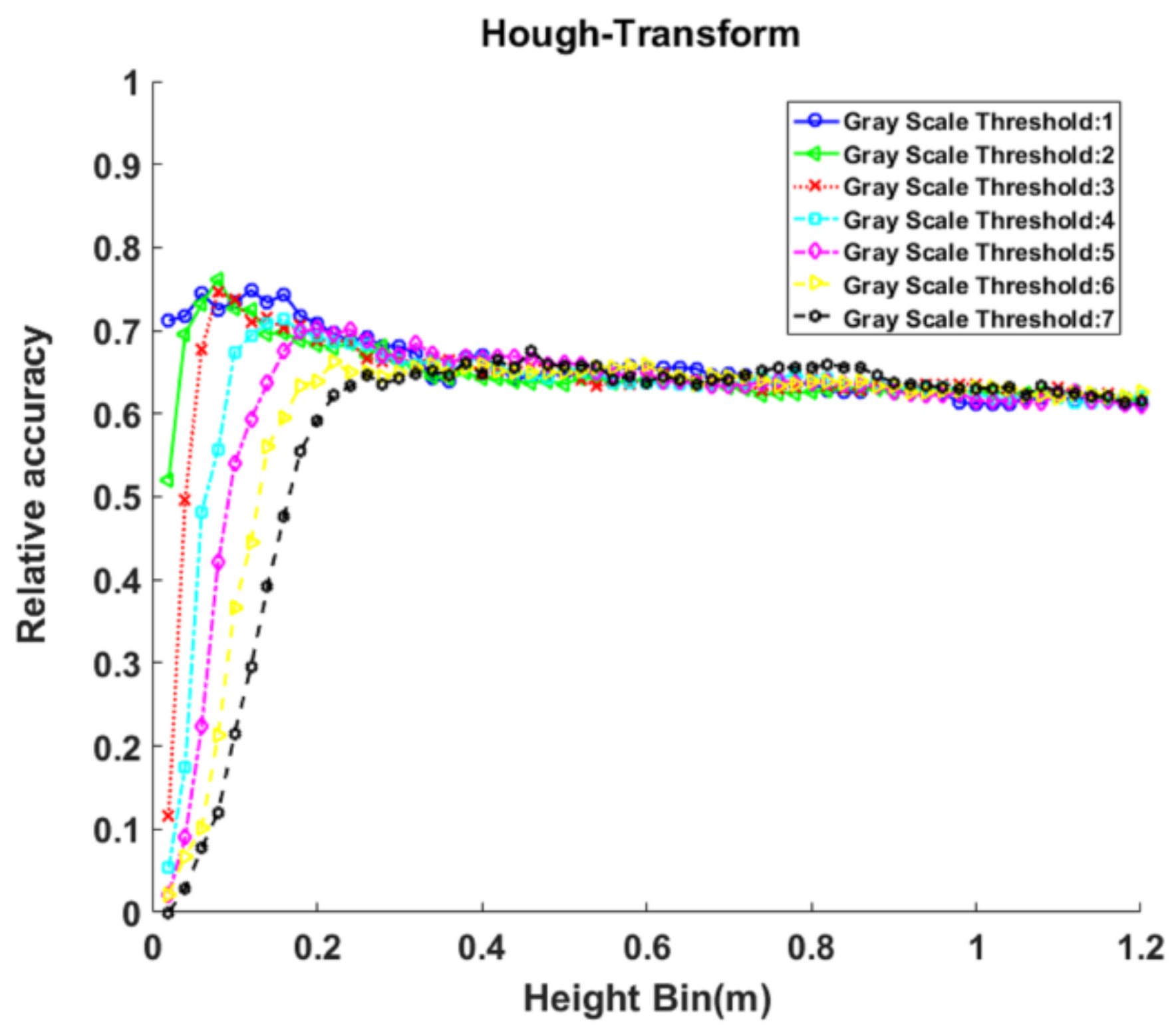
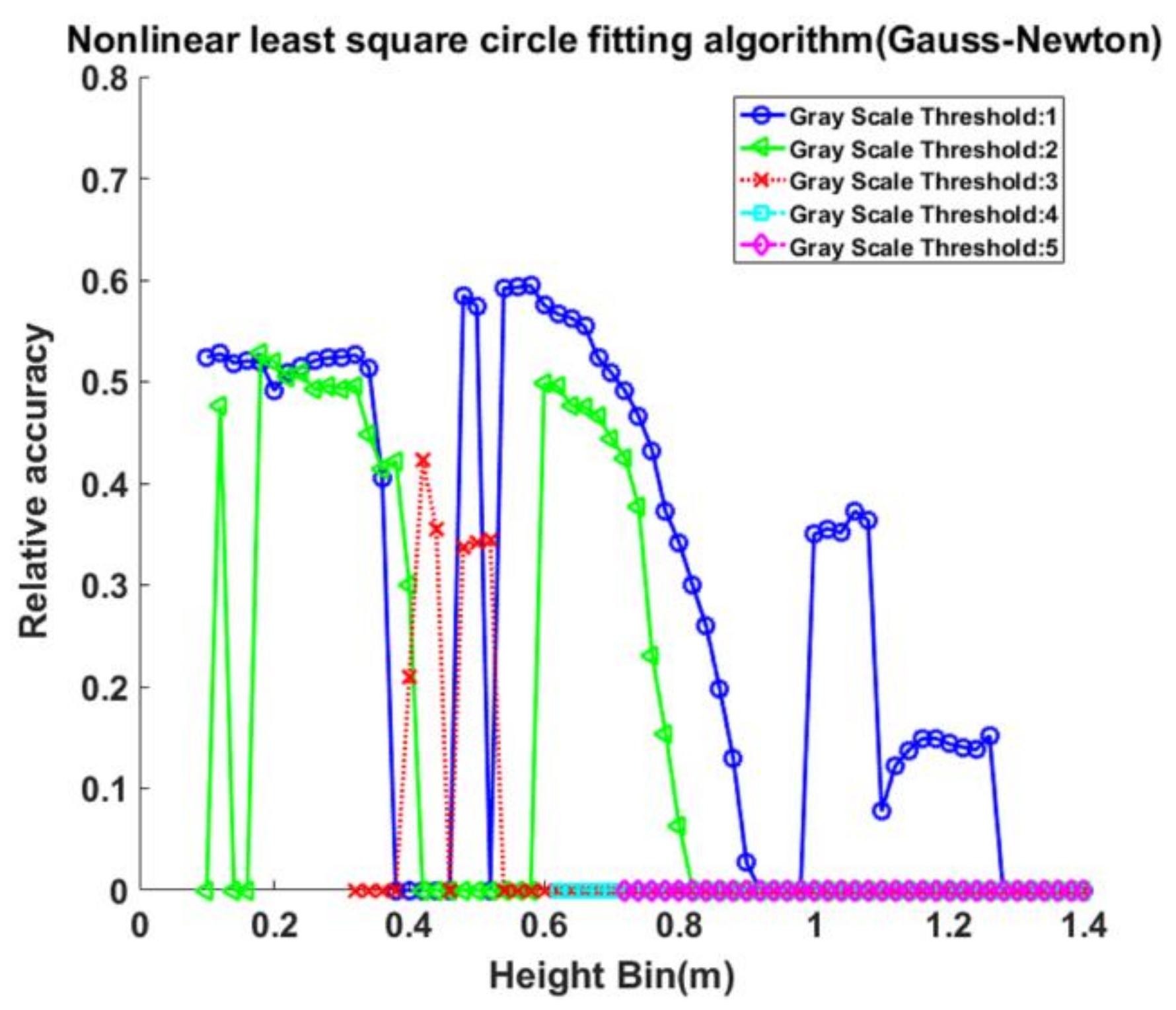
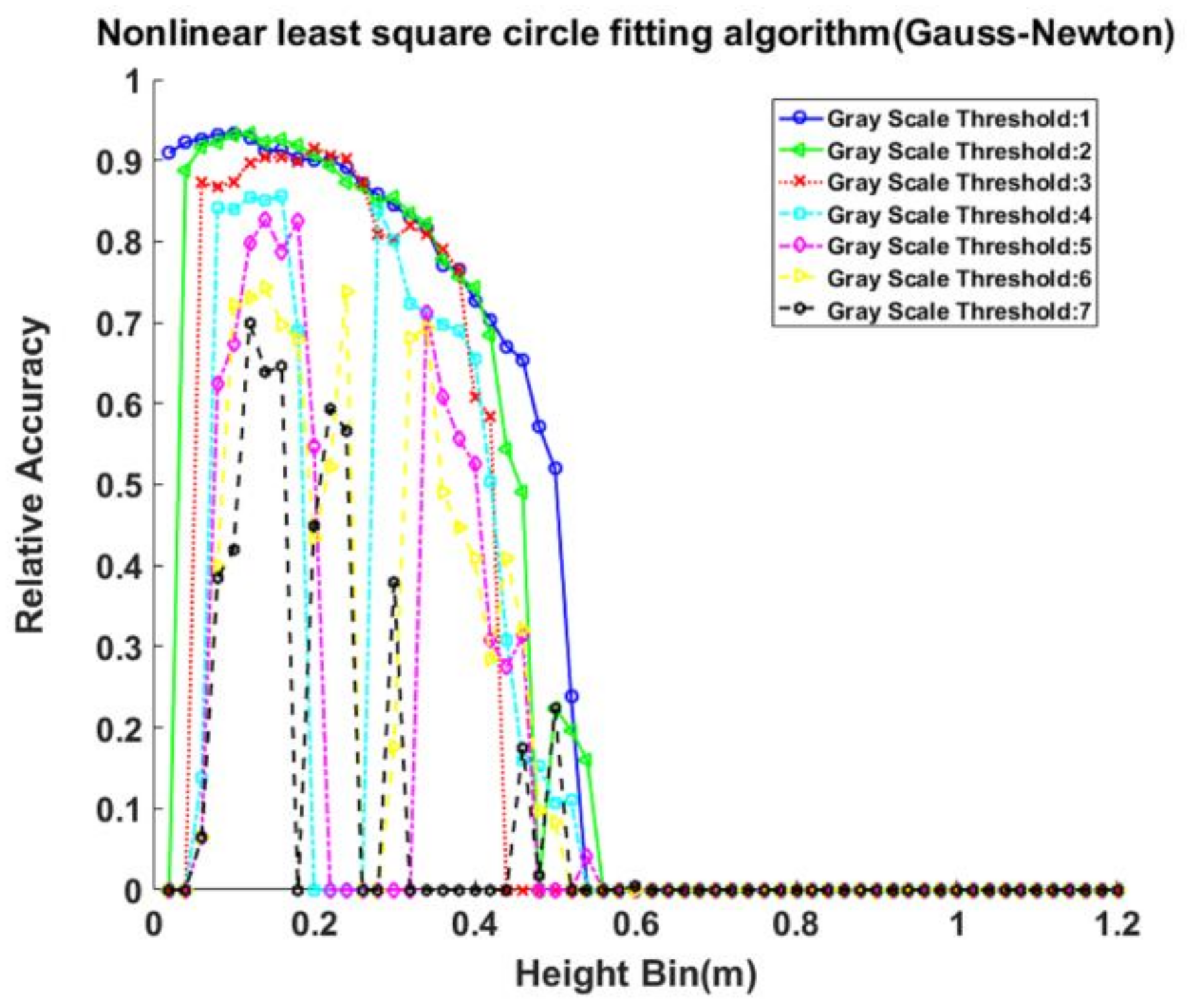

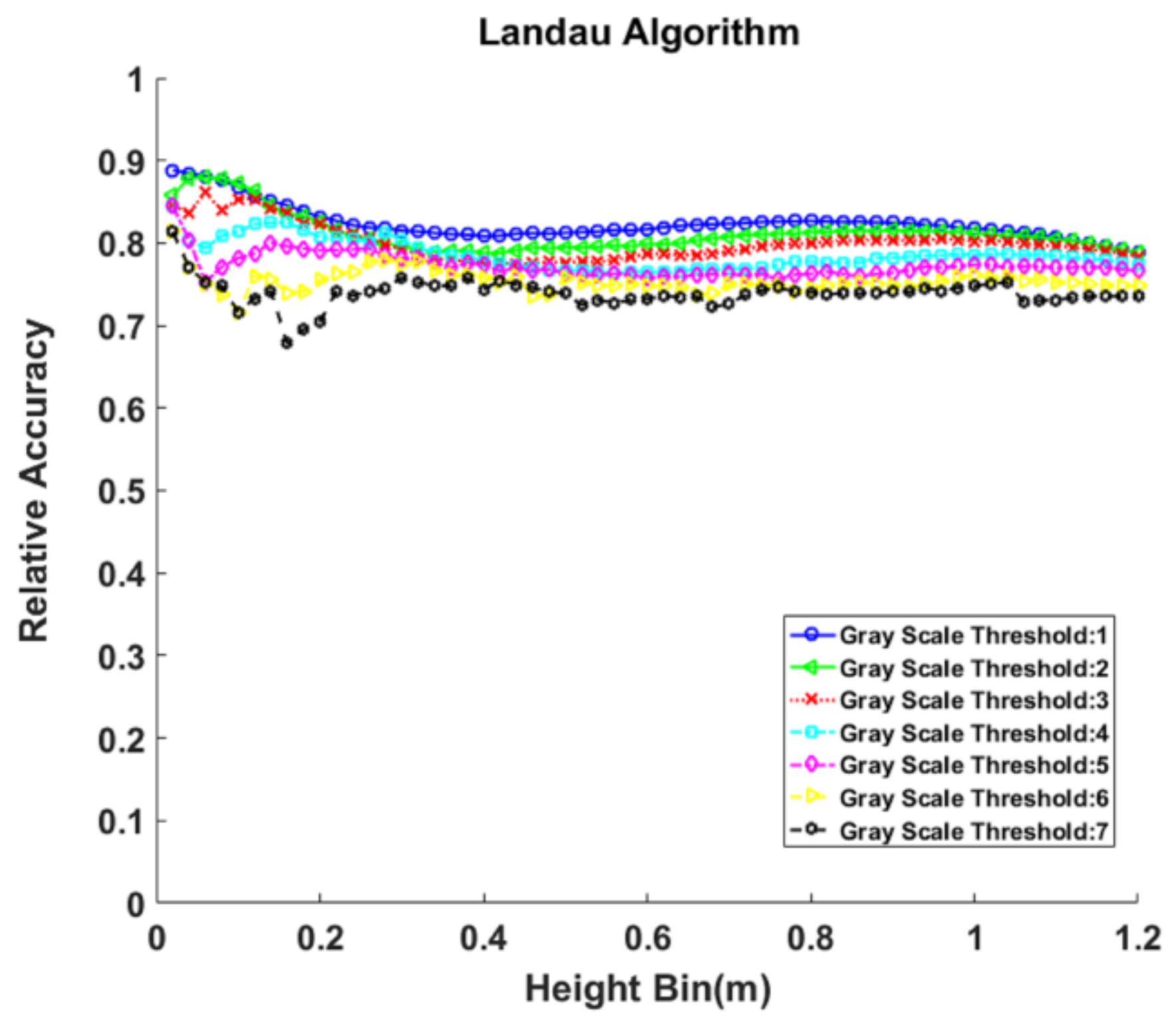
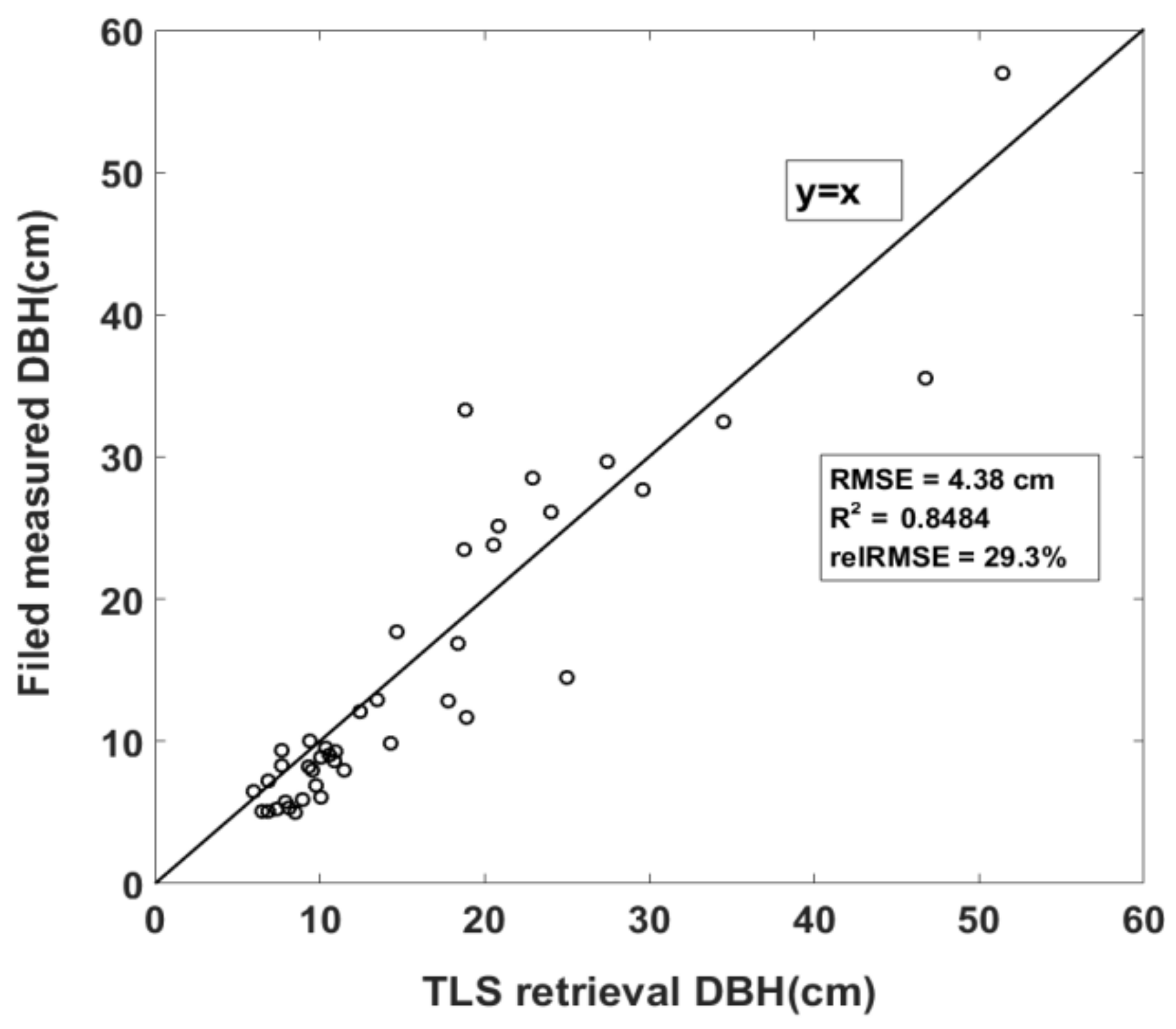
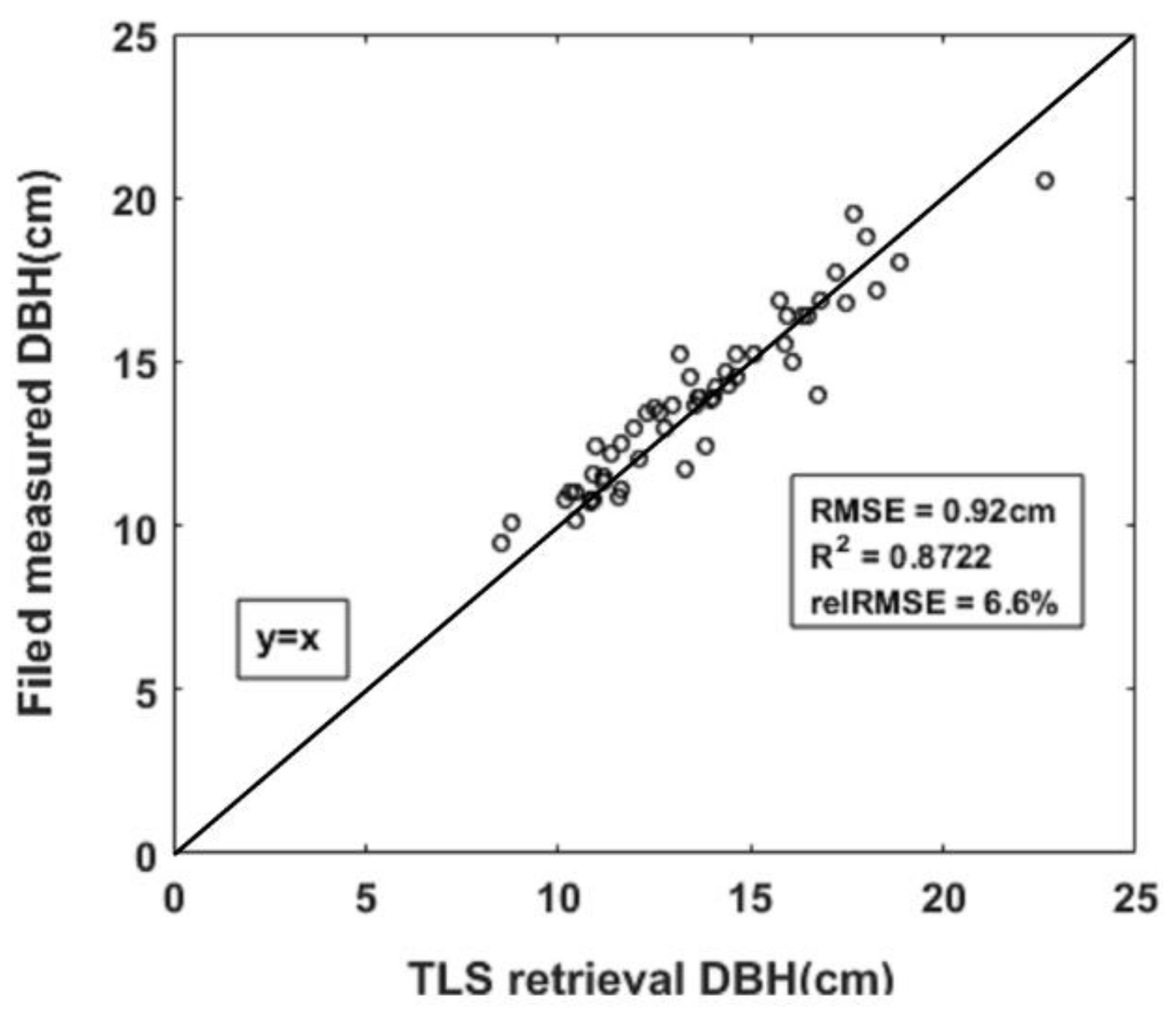
| Plot | Species | DBH (cm) | ||
|---|---|---|---|---|
| Min | Max | Mean | ||
| 1 | Larch | 5.1 | 17.7 | 7.8 |
| White birch | 6.4 | 33.3 | 22.2 | |
| Poplar | 10.5 | 23.8 | 18.7 | |
| All | 5.1 | 33.3 | 13.3 | |
| 2 | Larch | 6.6 | 57 | 16.1 |
| White birch | 5 | 27.7 | 14.4 | |
| Poplar | 32.5 | 32.5 | 32.5 | |
| All | 5 | 57 | 16.4 | |
| 3 | Mongolian oak | 9.5 | 20.5 | 13.8 |
| Plot | Scan Mode | Range of Height Bin (m) 1 | Range of Gray Scale Threshold 2 |
|---|---|---|---|
| 1, 2 | Multi-scan | 0.1–0.6 | 1–4 |
| 1, 2 | Single-scan | 0.1–0.3 | 1–2 |
| 0.32–0.6 | 1–3 | ||
| 0.62–0.7 | 1–4 | ||
| 0.72–1.4 | 1–5 | ||
| 3 | Single-scan | 0.02–1.2 | 1–7 |
| Plot | Scan Mode | Algorithm | RMSE of the Most Accurate Result (cm) |
|---|---|---|---|
| 1, 2 | Multi-scan | Hough-Transform | 12.79 |
| Landau algorithm | 1.77 | ||
| Nonlinear least square algorithm | 1.69 | ||
| Single-scan | Hough-Transform | 13.35 | |
| Landau algorithm | 4.38 | ||
| Nonlinear least square algorithm | 6.06 | ||
| 3 | Single-scan | Hough-Transform | 3.30 |
| Landau algorithm | 1.55 | ||
| Nonlinear least square algorithm | 0.92 |
© 2018 by the authors. Licensee MDPI, Basel, Switzerland. This article is an open access article distributed under the terms and conditions of the Creative Commons Attribution (CC BY) license (http://creativecommons.org/licenses/by/4.0/).
Share and Cite
Liu, C.; Xing, Y.; Duanmu, J.; Tian, X. Evaluating Different Methods for Estimating Diameter at Breast Height from Terrestrial Laser Scanning. Remote Sens. 2018, 10, 513. https://doi.org/10.3390/rs10040513
Liu C, Xing Y, Duanmu J, Tian X. Evaluating Different Methods for Estimating Diameter at Breast Height from Terrestrial Laser Scanning. Remote Sensing. 2018; 10(4):513. https://doi.org/10.3390/rs10040513
Chicago/Turabian StyleLiu, Chang, Yanqiu Xing, Jialong Duanmu, and Xin Tian. 2018. "Evaluating Different Methods for Estimating Diameter at Breast Height from Terrestrial Laser Scanning" Remote Sensing 10, no. 4: 513. https://doi.org/10.3390/rs10040513





